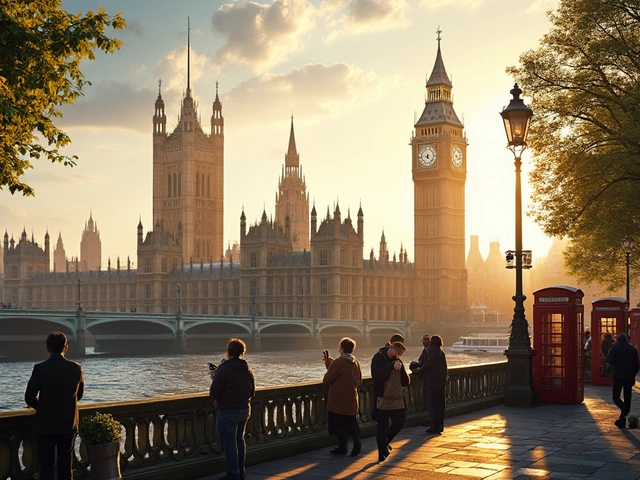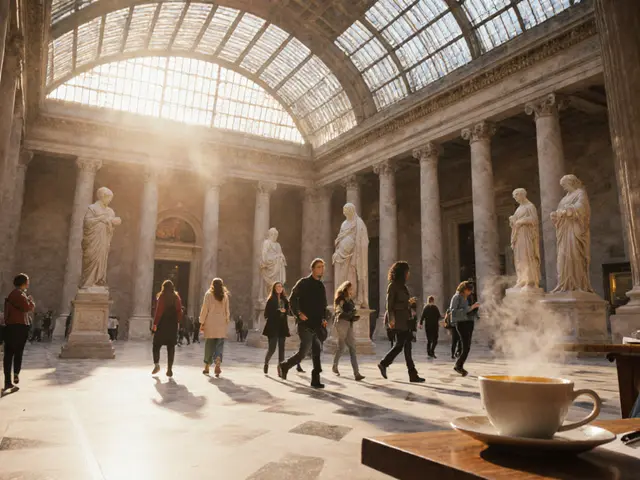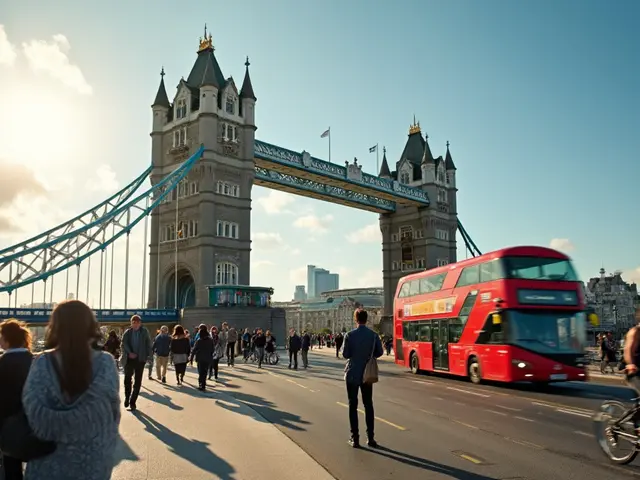Spotting something like The Shard or Tower Bridge in London doesn’t just mean you’re in the heart of the city—it means you’re brushing up against places where imagination has shaped real life. London’s iconic buildings aren’t just photo ops or markers on a map. They’re everyday backdrops, meeting points, shortcuts, and sometimes the way locals give directions (“Just head past the Gherkin and you’ll find it”).
Whether you’re a Londoner weaving through its busy streets or a visitor doing your best to keep up on a packed Saturday, these buildings set the pace. Want to find a late-night snack? The area around St Pancras buzzes even after dark. Fancy a memorable run? Lots of locals loop around the Thames, getting views of the London Eye and Westminster every single day. Kids never forget their first look at Buckingham Palace—mine still talks about the time he watched the Changing of the Guard, rain or shine.
Here’s the deal: every landmark brings together dreams and the grind of city life. They’re the places where friends meet before a gig, or where thousands pass by on a rushed Tuesday morning commute. Understanding them helps you tap into the real rhythm of London. Let’s dig into what makes each spot so central—not just for tourists wanting a perfect shot, but for those who live and breathe this city daily.
- London’s Skyline: Old Meets New
- Behind the Facade: Stories That Shaped the City
- Everyday Life Around the Landmarks
- Tips for Exploring London’s Iconic Architecture
London’s Skyline: Old Meets New
Walk through central London and you’ll spot everything from centuries-old cathedrals to steel-and-glass towers. That blend is what gives London its vibe. You’ve got the classic sights like St Paul’s Cathedral, finished way back in 1710, sitting just a stone’s throw from super-modern shapes like The Shard, which only opened to the public in 2013. You can actually see both in the same line of sight from spots along the Thames—there aren’t many cities where that’s possible.
The city is protective about its famous views too. Ever notice how you can always spy St Paul’s from certain angles? That’s on purpose. London has ‘protected views’—rules that keep new buildings from blocking out iconic landmarks. This means the skyline keeps its quirky mix instead of just becoming a field of skyscrapers.
Here are a few landmarks shaping the mix of old and new:
- The Shard - Tallest in the UK, 310m high, and you can book a ticket to the 72nd-floor viewing deck for city-wide views. It was designed by Renzo Piano and officially opened to visitors in 2013.
- The Gherkin (30 St Mary Axe) - Looks like a space-age bullet. It’s now a symbol for London’s business district and was finished in 2003.
- St Paul’s Cathedral - The dome dominates the skyline; Christopher Wren’s design survived WWII bombs and still hosts major national events.
- Tower Bridge - Not the oldest (it opened in 1894), but it’s on every postcard. Its Victorian style stands in stark contrast to nearby glass towers.
- The Walkie Talkie (20 Fenchurch Street) - Looks exactly as its nickname suggests. Home to the Sky Garden, which is free to visit if you book ahead online.
For those into numbers:
| Building | Year Opened | Height (m) |
|---|---|---|
| The Shard | 2013 | 310 |
| St Paul’s Cathedral | 1710 | 111 |
| The Gherkin | 2003 | 180 |
| Walkie Talkie | 2014 | 160 |
If you’re after the best spot for a photo, try standing on Waterloo Bridge at sunset. You’ll catch history and modern life in the same shot, no filter needed. Knowing how old rubs up against new here just makes every walk feel a bit more special.
Behind the Facade: Stories That Shaped the City
When people talk about London iconic buildings, they often miss what these structures have seen and survived. Most have stories that are way more dramatic than their glossy postcards let on.
Take St Paul’s Cathedral – it’s not just a big dome in the skyline. During World War II, it stood firm even when everything around it was bombed to bits. Londoners called it a symbol of hope because it somehow survived the Blitz, while much of the city went up in flames. On rainy city tours, guides love to remind folks how Sir Christopher Wren, the guy behind St Paul’s, tucked his own clever tricks into its design, like making sure you could hear someone whispering across the dome (test it out when you visit the Whispering Gallery).
Let’s not skip The Shard. Finished in 2012, it changed Southwark’s vibe overnight. It’s actually the UK’s tallest building and its glass spire is made from 11,000 panes. Some locals were unsure at first, but now you’ll hear people using it as a landmark for everything—first dates, job interviews, meetups. Plus, Renzo Piano, the Italian architect who designed it, wanted it to look like a shard of glass bursting out of the city. Guess that worked out, since you really can see it even from city suburbs like Wimbledon on a clear day.
Then you’ve got The Gherkin (officially 30 St Mary Axe). Back in the '90s, people thought it looked odd compared to older buildings, but it’s now one of London’s most recognisable shapes. The modern office blocks? Smart, with eco features before it was trendy. The Gherkin’s design saves about 50% on energy compared to a standard office block, all thanks to its ventilation setup and glass structure.
This city loves quirky stories. Did you know that Tower Bridge has a secret Victorian-era engine room you can still visit? Or that Buckingham Palace wasn’t always the royal home—it started as a townhouse for the Duke of Buckingham. The Queen only moved in after Queen Victoria made it official around 1837.
| Building | Year Completed | Fun Fact |
|---|---|---|
| St Paul’s Cathedral | 1708 | Survived WWII Blitz almost untouched. |
| The Shard | 2012 | Tallest building in the UK—72 habitable floors. |
| Tower Bridge | 1894 | Bascule design lets it open for river traffic. |
| The Gherkin | 2003 | Reduces energy use by 50% vs traditional buildings. |
| Buckingham Palace | 1837 | Became royal residence after Victoria’s coronation. |
Next time you’re walking past these spots, remember: you’re not just seeing pretty buildings. You’re catching glimpses of stories, secrets, and gutsy moments that have shaped London as it is today.
Everyday Life Around the Landmarks
Most locals breeze past places like London iconic buildings on their way to work, and yet, these spots are always in the mix whether you notice or not. Head down to London Bridge at rush hour and you’re walking alongside thousands making their way between the City and Borough Market. On sunny Fridays, office groups spill out around the Gherkin for after-work drinks, with street food vendors ready for the crowd. Not far off, Covent Garden isn’t just for tourists—loads of Londoners meet there after work, grabbing a pint or catching a street performance.
If you work near Canary Wharf, you know the feeling of dashing past the glass giants to grab lunch from a Pret or line up at Black Sheep Coffee. The West End’s theatres, clustered around Piccadilly Circus, draw crowds from all over the UK. At Christmas, Oxford Street is barely walkable because of shoppers ducking in and out of Selfridges, hunting for deals beneath the holiday lights. Families flock to South Bank for the skate park, book market, or just a lazy stroll with the London Eye overhead.
- Tip: Want fewer crowds? Visit these sights early in the morning—The Shard’s viewing platform is almost empty right at opening, and Tower Bridge has a relaxed vibe before commuter rush.
- Bankside’s riverside walkways are good for jogging or cycling, with plenty of spots to stop for food from Borough Market or at the Tate Modern café.
- Plenty of landmarks double up as co-working or meeting spaces—check out Somerset House for flexible workspace with a side of art and history.
- King’s Cross has become a hotspot for tech start-ups, with Google setting up base by the iconic station—there’s a great street food scene at Granary Square too.
The mix of history and modern hustle shows up in local stats too. Here’s a quick breakdown of just how much these buildings are woven into city life:
| Landmark | Daily Visitors | Main Use for Londoners |
|---|---|---|
| London Bridge | 250,000+ | Commuting, Markets |
| The Shard | 12,000 (includes workers & visitors) | Offices, Dining, Views |
| St Paul's Cathedral | Over 5,000 | Quiet Spaces, Events |
| South Bank | 40,000 (peak days) | Leisure, Festivals |
Knowing when and how to enjoy these places takes the edge off city living. Whether you’re dodging crowds, looking for a scenic jog, or searching for a quick meeting spot, London’s landmarks are more than just pretty faces. They’re baked into the practical, daily life of the city.
Tips for Exploring London’s Iconic Architecture
Getting the most out of London’s famous buildings isn’t just about snapping a classic photo. Here are tips that actually make your visit smoother and richer, whether you’re a local or hanging around for a few days.
- Plan your route ahead: The city’s traffic can be a pain during rush hour, and some landmarks are better done on foot. Try mixing the Tube with walking—hop off at Westminster for Big Ben and Parliament, or at London Bridge for The Shard and Tower Bridge in one go.
- Book tickets in advance: Major spots like the London Eye, St Paul’s Cathedral, and The Shard let you skip the long queues if you pay online. During summer and bank holidays, this can save hours.
- Look beyond the obvious: Sure, Buckingham Palace is a must-see, but places like the Leadenhall Building (the Cheesegrater) or the Barbican Estate let you see a different side of London iconic buildings. They’re usually less crowded, and sometimes host pop-up events or free art shows.
- Go up high: Want unbeatable views? Visit Sky Garden (it’s free, but you need to book), or try the rooftop at One New Change for St Paul’s views. Some locals swear by Primrose Hill too for a full skyline shot—minus the noise.
- Respect the locals: A lot of these sites double as workspaces, homes, or places of worship. St Paul’s and Westminster Abbey have actual church services. If you’re around, keep voices down and pauses for photos brief in quieter hours.
If you like numbers, check this quick view of just how much action some of these places see every year. No wonder they’ve perfected crowd management.
| Landmark | Annual Visitors (approximate) | Public Access |
|---|---|---|
| The Shard | 1.5 million | Paid (View from The Shard) |
| St Paul’s Cathedral | 2 million | Paid, free for worship |
| Tower Bridge | 900,000 | Paid (Exhibition), free to cross |
| Sky Garden | 600,000 | Free, but booking required |
| Westminster Abbey | 1.3 million | Paid, free for local worshippers |
Pro tip: Early mornings (before 10 am) or late afternoons (after 4 pm) are usually quieter at most major sites. And don’t underestimate the power of a good raincoat—London weather does what it wants, but that’s half the fun.



